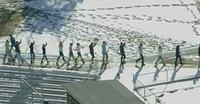-
Eight teams heading to DARPA Robotics Challenge finals

Two weeks ago, on 20-21 December 2013, sixteen teams were the main attraction at the DARPA Robotics Challenge (DRC) Trials, where they demonstrated their prototype robots’ ability to perform a number of critical real-world disaster-response skills. After two days of competition, the agency selected eight teams to receive up to $1 million in funding to continue their work and prepare for upcoming DARPA Robotics Challenge (DRC) Finals.
-
-
Palestinian ambassador to Czech Republic killed in explosion

Jamal al-Jamal, the Palestinian ambassador to the Czech Republic, was killed yesterday in a blast at his home in Suchdol, an upscale suburb north of Prague. The blast is believed to have been caused by explosives stored in a safe. When he opened the safe, the explosives went off. Riad al-Maliki, the Palestinian foreign minister, said that the safe had not been opened in at least thirty years. The ambassador moved to the new building in October, and workers moved the safe, unopened, from the old offices of the Prague Palestinian mission to the new one at that time.
-
-
Judge upholds New York gun restrictions -- except 7-round per magazine limit

A federal judge on Tuesday ruled that New York’s strict new gun laws, including an expanded ban on assault weapons, were constitutional. He struck down, though, a provision prohibiting gun owners from loading more than seven rounds into a magazine. The 54-page ruling by William M. Skretny of Federal District Court in Buffalo should be considered a victory for gun control advocates who saw gun control measures on the federal level stall. Judge Skretny, writing that “whether regulating firearms is wise or warranted is not a judicial question; it is a political one,” said that expanded bans on assault weapons and high-capacity magazines were legally sound because they served to “further the state’s important interest in public safety.”
-
-
FAA approves testing, developing standards for commercial use of drones
The Federal Aviation Administration(FAA) yesterday (Monday) has authorized test sites for UAVs. The FAA has selected six institutions to run the tests and operate the test sites. The test sites are part of a program to develop safety and operational rules for drones by the end of 2015, as mandated by Congress. Experts anticipate an exponential growth of drone use in the agriculture and law enforcement sectors. Analysts predict that more than 70,000 jobs would be created in the first three years after Congress approves drone use in U.S. skies, and that the global commercial drone market will reach $89 billion in the next decade.
-
-
16-year old Seattle girl escapes injury: her glasses deflect bullet
A 16-year old girl escaped potentially life-threatening injury when the glasses she was wearing deflected a bullet fired from a car toward her Seattle home, the Seattle police said. The girl was asleep on her living room couch, with her glasses on, near 10:00 p.m. on Saturday when several shots were fired at the house from a dark-colored sedan. Most of the bullets went through the walls of the house, but one of them went through the front window, striking the bridge of the teen’s glasses. The girl suffered only minor injuries.
-
-
Elbit Systems’ subsidiary to provide secure broadband mobile solution for first responders
DHS Science & Technology Directorate (S&T) has selected Elbit Systems of America, a wholly owned subsidiary of Elbit Systems, to provide a technology demonstrator for a secure broadband services solution for first responders. DHS will use this solution to test the new LTE broadband network with various mission critical secure multimedia services for public safety users. Following the integration and proof of concept phase, DHS will proceed with field tests within selected homeland security components.
-
-
Not all questions about the Tsarnaev brothers have been answered

What caused Tamerlan and Dzhokhar Tsarnaev to plant two bombs at the Boston Marathon finish line continues to puzzle investigators. Understanding the information which was available to local and federal law enforcement authorities before and after the attack might help prevent a future attack.
-
-
U.S. nuclear weapon programs to cost $355 billion over a decade: CBO
In its most recent review of U.S. nuclear policy, the Obama administration decided to maintain all three types of systems that can deliver nuclear weapons over long ranges — submarines that launch ballistic missiles (SSBNs), land-based intercontinental ballistic missiles (ICBMs), and long-range bombers — known collectively as the strategic nuclear triad. The administration also decided to preserve the ability to deploy U.S. tactical nuclear weapons carried by fighter aircraft overseas in support of allies. Nearly all of these delivery systems and the nuclear weapons they carry are nearing the end of their planned operational lives and will need to be modernized or replaced by new systems over the next two decades. The Congressional Budget Office (CBO) estimates that between 2014 and 2023, the costs of the administration’s plans for nuclear forces will total $355 billion.
-
-
Wearable body-cameras adopted by more police departments
Law enforcement agencies around the country are testing body-cameras on officers as a way to keep records of police interaction with the public. The cameras may be attached to hats, eyeglasses, or hung around the neck, giving the public and the courts a more intimate look at how police do their jobs.
-
-
Maine police uses social media, sponsored apps to fight crime
The accessibility of smartphones and the popularity of apps are making it easier for police to share and receive information from the public. Law enforcement agencies in Maine are using department-managed social media pages to engage with the public. Police department in money also use funds from recovered items and cash seized from drug busts to fund the development of apps which make it easier for the public to communicate with the police and report crimes.
-
-
Measures being offered to reduce mass shootings not likely to succeed

Criminologists debunk eleven common myths which dominate the discussion about how to put an end to, or at least reduce, the number and scope of mass shooting. They argue that the measures typically offered to deal with the problem — widening the availability of mental-health services, enhanced background checks, having armed guards at schools, censoring violent entertainment, especially video games, and more – would, at best, merely take a nibble out of the risk of mass murder. Even reducing mass shooting marginally would be a worthy goal, but “eliminating the risk of mass murder would involve extreme steps that we are unable or unwilling to take — abolishing the Second Amendment, achieving full employment, restoring our sense of community, and rounding up anyone who looks or acts at all suspicious. Mass murder just may be a price we must pay for living in a society where personal freedom is so highly valued,” they write.
-
-
U.S. Air Force plans to add 1,000 new cybersecurity personnel
Budget cuts notwithstanding, the U.S. Air Force plans to add 1,000 new personnel between 2014 and 2016 as part of its cybersecurity units. The 24th Air Force at Joint Base San Antonio-Lackland, Texas is home to the U.S. Air Force cyber command. With a budget of about $1 billion and a staff of roughly 400 military and civilian personnel, the command oversees about 6,000 cyber defense personnel throughout the Air Force.
-
-
Review panel calls for prohibiting NSA bulk collection of phone metadata
A 300-page report prepared for President Barack Obama made forty-six recommendations for better management of, and different guiding rules for, U.S. surveillance programs. Among the report’s recommendations: The NSA should be banned from attempting to undermine the security of the Internet and prohibited from collecting telephone records in bulk; spying on foreign leaders should require an authorization from a higher level then is currently the case; the government should be banned from undermining encryption. The president will announce by 28 January which of the forty-six recommendations he would accept.
-
-
Sandia to show Mine Rescue Robot at 2013 DARPA Robotics Challenge
Engineers from Sandia National Laboratories will demonstrate real-world robotics successes at the DARPA Robotics Challenge Trials 2013 Expo this week (20-21 December) in Florida. The challenge is focused on human-scaled robots that assist in humanitarian aid and disaster response. Sandia engineers will demonstrate the Gemini Scout Mine Rescue Robot, which was designed to overcome dangers lurking in a mining accident: poisonous gases, flooded tunnels, explosive vapors, and unstable walls and roofs. Such potentially deadly conditions and unknown obstacles can slow rescue efforts to a frustrating pace.
-
-
Federal judge: NSA's collection program violates Constitution

A federal judge, describing the NSA metadata collection program as “almost Orwellian,” yesterday ruled that the program which systematically collects and keeps records of all Americans’ phone calls most likely violates the Constitution. “I cannot imagine a more ‘indiscriminate’ and ‘arbitrary’ invasion than this systematic and high-tech collection and retention of personal data on virtually every single citizen for purposes of querying and analyzing it without prior judicial approval,” Judge Richard J. Leon wrote. “Surely, such a program infringes on ‘that degree of privacy’ that the founders enshrined in the Fourth Amendment.”
-
More headlines
The long view
Factories First: Winning the Drone War Before It Starts
Wars are won by factories before they are won on the battlefield,Martin C. Feldmann writes, noting that the United States lacks the manufacturing depth for the coming drone age. Rectifying this situation “will take far more than procurement tweaks,” Feldmann writes. “It demands a national-level, wartime-scale industrial mobilization.”
How Male Grievance Fuels Radicalization and Extremist Violence
Social extremism is evolving in reach and form. While traditional racial supremacy ideologies remain, contemporary movements are now often fueled by something more personal and emotionally resonant: male grievance.
The Surprising Reasons Floods and Other Disasters Are Deadlier at Night
It’s not just that it’s dark and people are asleep. Urban sprawl, confirmation bias, and other factors can play a role.
Why Flash Flood Warnings Will Continue to Go Unheeded
Experts say local education and community support are key to conveying risk.
